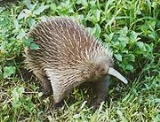
Western Long-beaked Echidna
Encyclopedia
The western long-beaked echidna (Zaglossus bruijni) is one of the four extant echidna
s and one of three species of Zaglossus that occur in New Guinea
. As Tachyglossus bruijni, this is the type species of Zaglossus.
The western long-beaked echidna is present in New Guinea, in regions of elevation between 1300 and 4000 m (4,265.1 and 13,123.4 ft); it is absent from the southern lowlands and north coast. Its preferred habitats are alpine meadow
and humid montane forests. Unlike the short-beaked echidna
, which eats ants and termites, the long-beaked species eats earthworms. The long-beaked echidna is also larger than the short-beaked species, reaching up to 16.5 kilograms (36.4 lb); the snout is longer and turns downward; and the spines are almost indistinguishable from the long fur. It is distinguished from the other Zaglossus species by the number of claws on the fore and hind feet: three (rarely four). It is the largest extant monotreme.
The species is listed as endangered by the IUCN; numbers have decreased due to human activities reducing habitat and hunting. The long-beaked echidna is a delicacy, and although commercial hunting of the species has been banned by the Indonesian and Papua New Guinean governments, traditional hunting is permitted.
In February 2006, an expedition led by Conservation International
reported finding a population of the mammals as part of what they described as a "lost world" of wildlife in the Foja Mountains
of Papua
Province, Indonesia
.
Echidna
Echidnas , also known as spiny anteaters, belong to the family Tachyglossidae in the monotreme order of egg-laying mammals. There are four extant species, which, together with the platypus, are the only surviving members of that order and are the only extant mammals that lay eggs...
s and one of three species of Zaglossus that occur in New Guinea
New Guinea
New Guinea is the world's second largest island, after Greenland, covering a land area of 786,000 km2. Located in the southwest Pacific Ocean, it lies geographically to the east of the Malay Archipelago, with which it is sometimes included as part of a greater Indo-Australian Archipelago...
. As Tachyglossus bruijni, this is the type species of Zaglossus.
The western long-beaked echidna is present in New Guinea, in regions of elevation between 1300 and 4000 m (4,265.1 and 13,123.4 ft); it is absent from the southern lowlands and north coast. Its preferred habitats are alpine meadow
Alpine tundra
Alpine tundra is a natural region that does not contain trees because it is at high altitude. Alpine tundra is distinguished from arctic tundra, because alpine soils are generally better drained than arctic soils...
and humid montane forests. Unlike the short-beaked echidna
Short-beaked Echidna
The short-beaked echidna , also known as the spiny anteater because of its diet of ants and termites, is one of four living species of echidna and the only member of the genus Tachyglossus...
, which eats ants and termites, the long-beaked species eats earthworms. The long-beaked echidna is also larger than the short-beaked species, reaching up to 16.5 kilograms (36.4 lb); the snout is longer and turns downward; and the spines are almost indistinguishable from the long fur. It is distinguished from the other Zaglossus species by the number of claws on the fore and hind feet: three (rarely four). It is the largest extant monotreme.
The species is listed as endangered by the IUCN; numbers have decreased due to human activities reducing habitat and hunting. The long-beaked echidna is a delicacy, and although commercial hunting of the species has been banned by the Indonesian and Papua New Guinean governments, traditional hunting is permitted.
In February 2006, an expedition led by Conservation International
Conservation International
Conservation International is a nonprofit organization headquartered in Arlington, Virginia, which seeks to ensure the health of humanity by protecting Earth's ecosystems and biodiversity. CI’s work focuses on six key initiatives that affect human well-being: climate, food security, freshwater...
reported finding a population of the mammals as part of what they described as a "lost world" of wildlife in the Foja Mountains
Foja Mountains
The Foja Mountains are located just north of the Mamberamo river basin in Papua, Indonesia. The mountains rise to , and have 3,000 square kilometres of old growth tropical rainforest in the interior part of the range...
of Papua
Papua (Indonesian province)
Papua comprises most of the western half of the island of New Guinea and nearby islands. Its capital is Jayapura. It's the largest and easternmost province of Indonesia. The province originally covered the entire western half of New Guinea...
Province, Indonesia
Indonesia
Indonesia , officially the Republic of Indonesia , is a country in Southeast Asia and Oceania. Indonesia is an archipelago comprising approximately 13,000 islands. It has 33 provinces with over 238 million people, and is the world's fourth most populous country. Indonesia is a republic, with an...
.
Further reading
- Augee, M and Gooden, B. 1993. Echidnas of Australia and New Guinea. Australian National History Press ISBN 978-0-86840-046-4
- Flannery, T.F. and Groves, C.P. 1998 A revision of the genus Zaglossus (Monotremata, Tachyglossidae), with description of new species and subspecies. Mammalia, 62(3): 367-396

